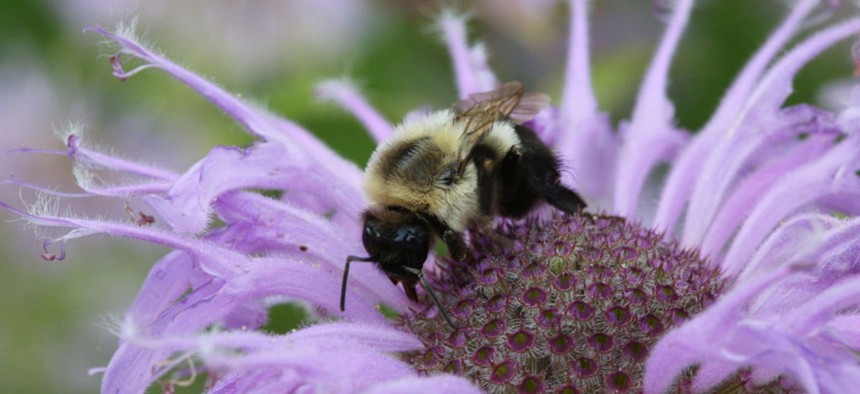Communities boost climate resilience by protecting pollinators

Photo by Creative Touch Imaging Ltd./NurPhoto via Getty Images
More cities are planting native plant-based gardens to slow loss of pollinators, which play a critical role in achieving climate adaptation goals.
A flash of black and yellow at a picnic table or the buzz of tiny wings may have diners reaching for the nearest fly swatter, but state and local officials across the country are taking a stand against insecticide in a bid to bolster local climate resiliency through biodiversity.
Communities can become more resilient to climate change through biodiversity conservation, or encouraging a variety of living things like native plants, animals and insects, said Carrianne Pershyn, biodiversity research manager at Ausable River Association, a New York-based nonprofit that works with local government agencies and organizations to protect their watersheds.
There’s also strength in numbers when it comes to climate change adaptation. The more trees and plants in a locality, she said, the more insects can survive, which in turn help keep alive hardier native vegetation, including crops, wildflowers and trees.
Enhancing biodiversity through plant and pollinator conservation offers communities a range of economic and environmental benefits, Dan Shaw, senior ecologist and vegetation specialist at Minnesota’s Board of Water and Soil Resources, said in an email to Route Fifty. For one, native vegetation doesn’t require as much maintenance as turf lawns or landscaping that uses imported or invasive plants, saving agencies time and money. Native plants also need less watering, fertilizers or pesticides, according to the Virginia Department of Conservation and Recreation.
Plus, native plants tend to have deeper roots than turf lawns or invasive species, allowing them to more effectively capture and filter rainwater, Shaw said. They also help communities boost water quality after storm events and help improve soil conditions, enabling landscapes to better retain water during droughts and produce healthy plants that more effectively sequester carbon.
That’s why Minnesota is addressing biodiversity from the ground up. In July, an omnibus finance bill went into effect that includes a requirement for local governments to allow property owners to keep and maintain natural landscapes on their lawns. Policymakers defined natural landscapes as “planned, intentional and maintained planting of native or nonnative grasses, wildflowers, forbs, ferns, shrubs or trees, including but not limited to rain gardens, meadow vegetation and ornamental plants.”
Besides reducing maintenance and saving water, these natural areas create pollinator habitats that can help reverse the decline of Minnesota’s state bee, the rusty patched bumblebee, which has experienced an 80% population decline over the last 20 years, Shaw said.
Minnesotans have signed onto saving their bumble bee and improving biodiversity. In 2019, the state’s Board of Water and Soil Resources launched the Lawns to Legumes grant program through which residents can apply for funding to replace their turf lawns with pollinator-friendly habitats. The program has received more than 22,000 applicants since its launch, Shaw said, and more than 3,500 pollinator projects have been completed.
An online interactive map enables policymakers and community members to map the program’s progress and keep track of where new pollinator habitats are created, Shaw said. To date, the grant has helped increase pollinator habits in Minnesota by more than five million square feet. And the state has seen more than 1,000 independent projects listed on the map, meaning individuals are building up or restoring pollinator-friendly landscapes without program funding.
“Planting pollinator gardens is a clear action people can take to be part of the solution to address pollinator population decline,” Shaw said. “We’ve also found that this program brings people together and strengthens communities [as] people share ideas, tips [and] seeds within their own communities to make a difference.”
Other cities like San Diego and Encinitas in California have joined the Bee City USA program, an initiative supported by the Xerces Society, a nonprofit dedicated to biodiversity and ecosystem management. Bee City USA helps local governments craft conservation frameworks to protect pollinators from current and future environmental threats like habitat loss or harmful pesticides.
The San Diego’s Environment Committee approved a memorandum of understanding in August to enroll the city in the program, which only costs $500 a year. As a member, the city can leverage the organization’s resources like subject matter experts and federal grant opportunities.
City Councilmember and Environment Committee Chair Joe LaCava said programs like Bee City USA create “an opportunity for us to establish our values and pivot our operations towards these [biodiversity] objectives all within our current work plans and current budget.”






